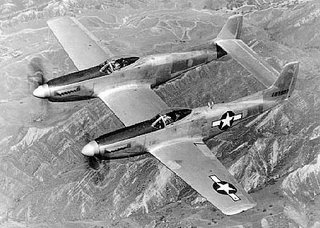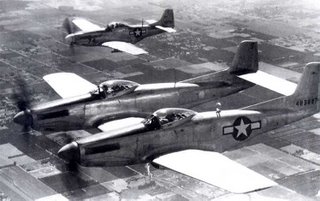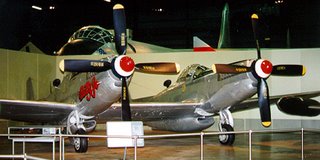Tarmac Saturday
Two is better than one, right? North American certainly thought so when they created the F-82 Twin Mustang, which is today's feature.
The Twin Mustang is an interesting aircraft. Originally conceived in the waning years of WWII as a long range escort fighter for B-29 raids over Japan, it was turned into a night fighter, fought the first (and one of the most important) air battles of the Korean War, and had its swansong flying its original mission, escorting the gargantuan B-36 over the Arctic.
As I said, the Twin Mustang was designed as a long range escort fighter for B-29 raids on Japan. Both cockpits had flight controls; this was to help alleviate pilot fatigue on the anticipated long raids in the relatively cramped cockpit of a fighter. While the F-82 simply looks like two P-51Hs joined together, it was actually a completely new design. Each fuselage was slightly lengthened, and the plane featured a completely new center wing section, tail, propellers, in addition to having a new four wheel landing gear. Good picture here featuring both aircraft:
An interesting feature of the F-82 is that it is the only USAF aircraft to have a trainer version with more available power than the line version. The reason for this is that the prototypes and early P-82B models were powered by the excellent Rolls-Royce Merlin engine. Unfortunately, political pressure forced North American to start using the U.S. produced inferior Allison V-1710 with the P-82C model, which resulted in a lower top speed and poorer high altitude performance. The -B model was designated as a trainer while the -C was the first one to see real line duty, so the end result was the only USAF aircraft whose trainer version was more powerful than the standard version.
As you may have guessed, the end of WWII eliminated the n eed for a B-29 long range escort fighter, but the USAF needed a replacement for its old P-61 Black Widow night fighters. As I mentioned last week, all-weather jet interceptors were in rather short supply immediately after WWII, so the F-82 was drafted to stand in. This model was designated the F-82G, and was substantially different than the standard escort fighter. The biggest difference was the mounting of a radar in a "long dong" pod beneath the center wing section. The radar was operated from the right side seat, where the co-pilot's station was replaced with a radar operator's station.
eed for a B-29 long range escort fighter, but the USAF needed a replacement for its old P-61 Black Widow night fighters. As I mentioned last week, all-weather jet interceptors were in rather short supply immediately after WWII, so the F-82 was drafted to stand in. This model was designated the F-82G, and was substantially different than the standard escort fighter. The biggest difference was the mounting of a radar in a "long dong" pod beneath the center wing section. The radar was operated from the right side seat, where the co-pilot's station was replaced with a radar operator's station.
The F-82G saw service in the opening months of the Korean Conflict, including, as I mentioned above, one of the most pivotal and least-known air battles of the conflict. Wikipedia has a good summary of the incident here. Suffice to say that it is very possible that the presence of F-82Gs overhead while civilian evac ops were going on may have prevented the escalation of the Korean War into WWIII. In addition to this pivotal battle, the F-82G saw service in Korea until 1951, when it was replaced with the F-94 Starfire. At this time, all F-82Gs were rotated through a depot in Japan where they were upgraded to the F-82L standard, which equipped them for cold weather ops, primarily escorting B-36 Peacemaker bombers in the Arctic. The -L model served in this duty until a lack of spare parts and high hours made it prohibitive to keep them flying, resulting in the retiring of the fleet in 1954. The F-82 was the last piston engined fighter to fly for the USAF.
air battles of the conflict. Wikipedia has a good summary of the incident here. Suffice to say that it is very possible that the presence of F-82Gs overhead while civilian evac ops were going on may have prevented the escalation of the Korean War into WWIII. In addition to this pivotal battle, the F-82G saw service in Korea until 1951, when it was replaced with the F-94 Starfire. At this time, all F-82Gs were rotated through a depot in Japan where they were upgraded to the F-82L standard, which equipped them for cold weather ops, primarily escorting B-36 Peacemaker bombers in the Arctic. The -L model served in this duty until a lack of spare parts and high hours made it prohibitive to keep them flying, resulting in the retiring of the fleet in 1954. The F-82 was the last piston engined fighter to fly for the USAF.
However, this is not the F-82's only claim to fame. On 27 Feb. 1947 , a P-82B named "Betty Jo" set a record that stands to this day when it flew the 5,051 miles from Hawaii to NYC. This flight set and holds the records for longest non-stop flight made by a propeller driven fighter, and the fastest that such a distance has been covered in a piston-engined aircraft.
, a P-82B named "Betty Jo" set a record that stands to this day when it flew the 5,051 miles from Hawaii to NYC. This flight set and holds the records for longest non-stop flight made by a propeller driven fighter, and the fastest that such a distance has been covered in a piston-engined aircraft.
That will wrap it up for this week's feature; hope you enjoyed it. Be sure to check out SJS's Flightdeck Friday. He's discussing the P4M Mercator and other ferrets. Also, next week be on the lookout for something completely different: a enormous intercontinental cruise missile powered by a nuclear reactor.

The Twin Mustang is an interesting aircraft. Originally conceived in the waning years of WWII as a long range escort fighter for B-29 raids over Japan, it was turned into a night fighter, fought the first (and one of the most important) air battles of the Korean War, and had its swansong flying its original mission, escorting the gargantuan B-36 over the Arctic.
As I said, the Twin Mustang was designed as a long range escort fighter for B-29 raids on Japan. Both cockpits had flight controls; this was to help alleviate pilot fatigue on the anticipated long raids in the relatively cramped cockpit of a fighter. While the F-82 simply looks like two P-51Hs joined together, it was actually a completely new design. Each fuselage was slightly lengthened, and the plane featured a completely new center wing section, tail, propellers, in addition to having a new four wheel landing gear. Good picture here featuring both aircraft:

An interesting feature of the F-82 is that it is the only USAF aircraft to have a trainer version with more available power than the line version. The reason for this is that the prototypes and early P-82B models were powered by the excellent Rolls-Royce Merlin engine. Unfortunately, political pressure forced North American to start using the U.S. produced inferior Allison V-1710 with the P-82C model, which resulted in a lower top speed and poorer high altitude performance. The -B model was designated as a trainer while the -C was the first one to see real line duty, so the end result was the only USAF aircraft whose trainer version was more powerful than the standard version.
As you may have guessed, the end of WWII eliminated the n
 eed for a B-29 long range escort fighter, but the USAF needed a replacement for its old P-61 Black Widow night fighters. As I mentioned last week, all-weather jet interceptors were in rather short supply immediately after WWII, so the F-82 was drafted to stand in. This model was designated the F-82G, and was substantially different than the standard escort fighter. The biggest difference was the mounting of a radar in a "long dong" pod beneath the center wing section. The radar was operated from the right side seat, where the co-pilot's station was replaced with a radar operator's station.
eed for a B-29 long range escort fighter, but the USAF needed a replacement for its old P-61 Black Widow night fighters. As I mentioned last week, all-weather jet interceptors were in rather short supply immediately after WWII, so the F-82 was drafted to stand in. This model was designated the F-82G, and was substantially different than the standard escort fighter. The biggest difference was the mounting of a radar in a "long dong" pod beneath the center wing section. The radar was operated from the right side seat, where the co-pilot's station was replaced with a radar operator's station.The F-82G saw service in the opening months of the Korean Conflict, including, as I mentioned above, one of the most pivotal and least-known
 air battles of the conflict. Wikipedia has a good summary of the incident here. Suffice to say that it is very possible that the presence of F-82Gs overhead while civilian evac ops were going on may have prevented the escalation of the Korean War into WWIII. In addition to this pivotal battle, the F-82G saw service in Korea until 1951, when it was replaced with the F-94 Starfire. At this time, all F-82Gs were rotated through a depot in Japan where they were upgraded to the F-82L standard, which equipped them for cold weather ops, primarily escorting B-36 Peacemaker bombers in the Arctic. The -L model served in this duty until a lack of spare parts and high hours made it prohibitive to keep them flying, resulting in the retiring of the fleet in 1954. The F-82 was the last piston engined fighter to fly for the USAF.
air battles of the conflict. Wikipedia has a good summary of the incident here. Suffice to say that it is very possible that the presence of F-82Gs overhead while civilian evac ops were going on may have prevented the escalation of the Korean War into WWIII. In addition to this pivotal battle, the F-82G saw service in Korea until 1951, when it was replaced with the F-94 Starfire. At this time, all F-82Gs were rotated through a depot in Japan where they were upgraded to the F-82L standard, which equipped them for cold weather ops, primarily escorting B-36 Peacemaker bombers in the Arctic. The -L model served in this duty until a lack of spare parts and high hours made it prohibitive to keep them flying, resulting in the retiring of the fleet in 1954. The F-82 was the last piston engined fighter to fly for the USAF.However, this is not the F-82's only claim to fame. On 27 Feb. 1947
 , a P-82B named "Betty Jo" set a record that stands to this day when it flew the 5,051 miles from Hawaii to NYC. This flight set and holds the records for longest non-stop flight made by a propeller driven fighter, and the fastest that such a distance has been covered in a piston-engined aircraft.
, a P-82B named "Betty Jo" set a record that stands to this day when it flew the 5,051 miles from Hawaii to NYC. This flight set and holds the records for longest non-stop flight made by a propeller driven fighter, and the fastest that such a distance has been covered in a piston-engined aircraft.That will wrap it up for this week's feature; hope you enjoyed it. Be sure to check out SJS's Flightdeck Friday. He's discussing the P4M Mercator and other ferrets. Also, next week be on the lookout for something completely different: a enormous intercontinental cruise missile powered by a nuclear reactor.








<< Home